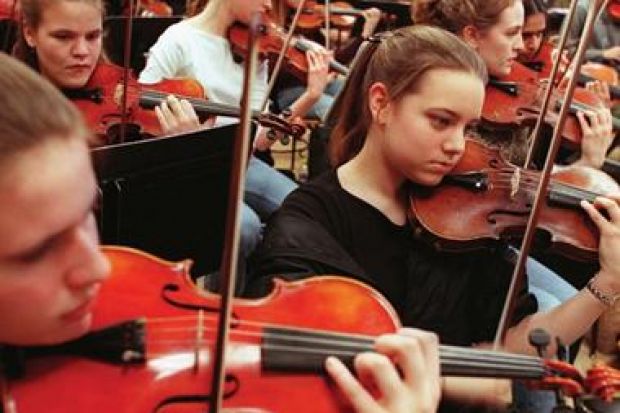If you collect the many dozens of articles written in the past year or so about the state and future of the arts in education and place them on a pair of positive/negative scales, there’d be very little – if anything – on the positive side.
Thinking about this I was reminded of a book I read years ago, which remains one of my favourite books (it’s also on Neil Gaiman’s list of all-time favourites, so I’m in good company). The book is called Lud-in-the-Mist, written in 1926 by Hope Mirrlees. Mirrlees was a classicist, and much of her work dealt with the contested boundaries of art and life.
In Lud-in-the-Mist there are two countries. There is the land of Dorimare, a nation of stolid burghers, merchants and artisans. A rather prim and very proper place, where everyone knows their place, where the motto is essentially “it’s the economy, stupid” , and where the arts are relegated to activities such as needlework and country dancing: pursuits for the refinement of gentlewomen and gentlemen.
On the border of Dorimare, however, on the other side of the Debatable Hills, lies the land of Faerie, a strange, dark land full of mysteries and wonders…not all of them pleasant. The upright citizens of Dorimare so fear the land that lies beyond those dread hills, that the word “Faerie” is never to be uttered.
Read more: Can philosophy survive in an academy driven by impact
Dorimare’s main city of Lud-in-the-Mist lies at the confluence of two rivers: the Dapple and the Dawl. The Dawl is like any other commercial river, but the Dapple happens to flow out of the land of Faerie, and brings with it fairy fruit, that is smuggled into Dorimare. Eating fairy fruit has a terrible effect: it causes people to start singing strange songs, to spout poetry, to dance with abandon.
In other words, it turns them mad.
The plot revolves around the disappearance of a group of young ladies and the mayor’s son who have been kidnapped and taken to the land of Faerie, and the attempt of the mayor, a bumbling, self-important, rather fatuous man to rescue them. As a consequence of that quest, fundamental changes are wrought – to the mayor and to Dorimare itself.
In Lud-in-the-Mist, Mirrlees is dealing with the division of the world into Apollonian and Dionysian aspects: the homely and the wild. There is also the long battle between Classicism and Romanticism, and Freud’s theories of the conscious and unconscious mind, and the relationship between terror and beauty.
The actor Mark Rylance, in a recent interview, said that the arts are essentially “mysterious”, which is why they frighten politicians and policymakers, because they can’t control them, they can’t measure them.
I imagine that the educational curriculum in Dorimare’s schools is very much like the one demanded by Gradgrind in Dickens’ Hard Times: “Now, what I want is Facts. Teach these boys and girls nothing but Facts. Facts alone are wanted in life. Plant nothing else, and root out everything else. You can only form the mind of reasoning animals upon Facts: nothing else will ever be of any service to them.”
And if you think that’s rather extreme, consider this – handed to parents at primary schools in 2015: “The new programme of study in English is knowledge-based, this means its focus is on knowing facts rather than developing skills and understanding. It is also characterised by an increased emphasis on the technical aspects of language and less on the creative aspects.”
I was once asked, by the then German federal minister of education as it happens, as we stood together in the queue for coffee at a conference on the future of arts education in Europe, what it was that had made the UK such a world leader in art, design, fashion, music, theatre. He was comparing the UK with his own country and the fact that, with a few notable exceptions, Germany had demonstrated nothing like that level of consistent creative output.
I didn’t have a rigorously researched, evidence-based answer to give him, but I did say that I thought it had something to do with our long history and tradition of non-conformity, of sticking two fingers up to authority, and our high tolerance of eccentricity. Neither of which, I suggested humbly, were common attributes in his own country.
The minister said “Ah, that’s very interesting”…and moved on.
I was thinking about Lud-in-the-Mist because it seems to me that we are increasingly living in a country that is becoming more Dorimare-like by the day, where the arts are increasingly banished to the equivalent of the land of Faerie, where creativity is associated with the creation of goods and wealth, where any hint of an artistic or genuinely creative spirit is dismissed as bad influence, and to be actively discouraged and eliminated.
In our education system there is now a very real danger of replacing genuine creativity with skills acquisition, wonder with tick-box excellence, and mystery with an impact case study.
So, how might we truly embrace the arts and our creative non-conformists, eccentrics and mavericks, or are we fated to banish them to that strange, mysterious, wonderful land beyond the Debatable Hills?
Paul Kleiman is a higher education consultant and visiting professor at Middlesex University and Rose Bruford College. This post was originally published on his personal blog.
Register to continue
Why register?
- Registration is free and only takes a moment
- Once registered, you can read 3 articles a month
- Sign up for our newsletter
Subscribe
Or subscribe for unlimited access to:
- Unlimited access to news, views, insights & reviews
- Digital editions
- Digital access to THE’s university and college rankings analysis
Already registered or a current subscriber? Login




